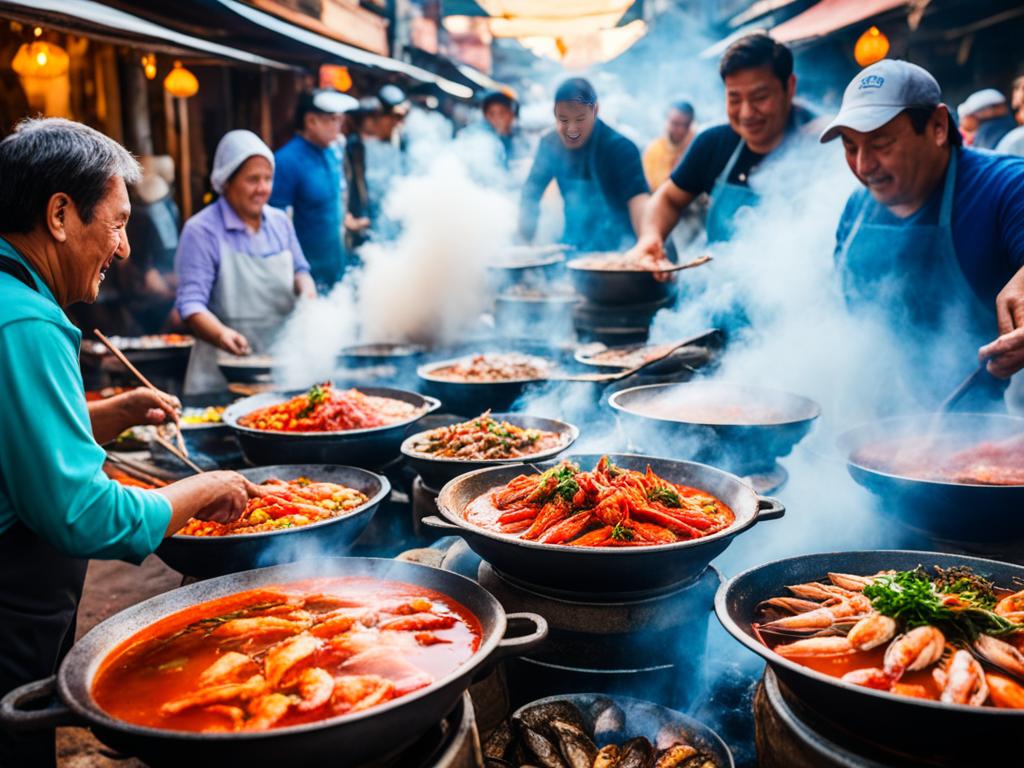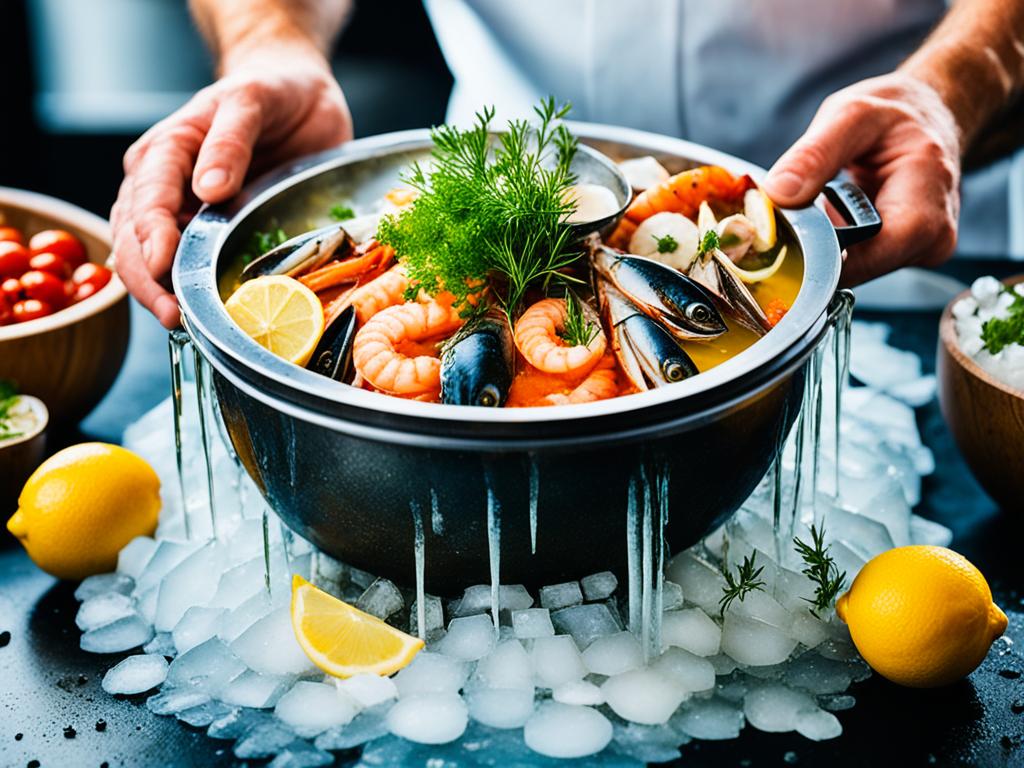Mastering Seafood Poaching: My Top Tips & Tricks
You might think the only ways to cook fish and shellfish are grilling or frying. But, there’s another method that brings out a whole new world of flavors. That’s poaching. It’s my favorite way to make seafood juicy and full of aromatic tastes. It works well for all kinds of seafood, from light fillets to rich shellfish.
Let’s dive into the best way to poach seafood. Think of seafood soaking up a delicious, flavorful liquid. This could be a tasty broth, wine, beer, or even soda. Each one adds its unique flavor to your dish. I’ll show you the best liquids to use for different seafood. And how to whip up a poaching liquid in less than 10 minutes. This will turn your kitchen into a top-notch dining spot.
I’ll share seafood poaching techniques to keep your dishes tender and beautiful. Plus, get ready for some of my own poached seafood recipes. You’ll learn the power of gentle heat, perfect timing, and a touch of rich fats. A bit of high-quality olive oil or butter can take your seafood from okay to amazing.
Key Takeaways
- Discover the best liquids to use for poaching different seafood varieties.
- Uncover how maintaining the correct temperature can enhance seafood’s natural flavors.
- Gain insights into the timing and handling of seafood to achieve poached perfection.
- Explore how to finish your poached seafood with fats and seasonings for that extra zing.
- Learn how to create a sensational poaching liquid that will become a recipe favorite.
Introduction to Seafood Poaching
Exploring the art of poaching seafood might look complicated. But this easy seafood poaching guide simplifies the technique, making it reachable for everyone. By keeping a gentle simmer and taking it slow, we make sure each bite is juicy and tender.

The Philosophy Behind Gentle Cooking Techniques
Gentle simmering is key in seafood poaching. It brings out seafood’s natural beauty and taste without high heat. Using medium heat lets poachers bring out the best in their dishes. This method is a fundamental part of fine seafood cooking.
Understanding the Versatility of Poaching Different Seafood
The range of poaching liquids varies greatly. They range from simple saltwater to aromatic court bouillon. This variety adds unique flavors that highlight each seafood’s qualities. The method works well for everything from soft fish to sturdy shellfish.
| Seafood Type | Recommended Poaching Liquid | Poaching Time |
|---|---|---|
| Salmon | White wine & herbs | 10-15 minutes |
| Shrimp | Lemon & garlic broth | 3-5 minutes |
| Scallops | Saffron infused broth | 5 minutes |
| Lobster | Court bouillon | 12-15 minutes |
Learning how to poach keeps seafood’s structure and boosts its taste. It’s a technique all cooking fans should try. Give it a go and see how medium heat and gentle simmer change your seafood game. This easy seafood poaching guide is a great start to mastering poaching.
Choosing the Right Seafood for Poaching
When picking seafood for poaching, your choice matters a lot. Choosing lean fish like flounder or sole is good for oil poaching. Fatty fish like salmon, on the other hand, are best in broths. I’ve learned it’s crucial to consider the seafood’s freshness and taste, as poaching highlights these.
Here’s a quick guide I made to help you pick seafood for poaching:
| Type of Fish | Recommended Poaching Method | Beneficial Fats for Finishing |
|---|---|---|
| Lean Fish | Oil Poaching | Sesame Oil, Extra-Virgin Olive Oil |
| Fatty Fish | Broth Poaching | Niter Kibbeh, Grass-fed Butter |
If you’re into shellfish, consider this poached shrimp tutorial. Choose fresh shrimp. Clean them, then poach gently in court bouillon or water with herbs and lemon. Keeping the heat low is vital to keep shrimp tender and tasty.

Understanding your ingredients and their reactions to cooking is crucial. Whether you use a lean or fatty seafood, each brings unique flavors and textures. Choosing wisely can turn a simple dish into a gourmet meal!
How to Poach Seafood: Step-By-Step Guide
Poaching seafood makes it juicy and full of flavor. You simmer fish or shellfish in tasty liquid at a gentle heat. Here’s a simple guide to poach seafood perfectly, even on your first try!
Preparation of Poaching Liquid
The key to great poached seafood is the liquid. Mix broth, herbs, and sometimes wine for the perfect base. For scallops, use light broths to keep their taste fresh. Trying white wine with herbs like dill or parsley is a good idea.
Managing the Perfect Heat
The right heat is important. It cooks the seafood without making it hard. Keep the liquid between 140°F and 160°F. Use a thermometer to make sure it doesn’t boil.
Timing Your Seafood to Poached Perfection
With fish, timing is key. Thick cuts might need up to 10 minutes. Delicate scallops could take just a few minutes. Watch the seafood closely to keep it from overcooking and turning tough.
| Seafood Type | Thickness | Approx Cook Time (Min) |
|---|---|---|
| Fish Fillet | 1 inch | 7-10 |
| Scallops | 1/2 inch | 2-4 |
| Whole Fish | 2 inches | 10-12 |
Try different seasonings and liquids to find what you like. Remember, poaching should enhance the seafood’s flavor, not hide it. Enjoy finding your favorite flavors and creating delicious dishes!
The Art of Enhancing Flavor: Seasoning and Poaching Liquids
Poaching is a cooking method that can greatly improve delicate foods. It brings out natural flavors in seafood and other foods. This is done using a poaching liquid with the right seasonings. A good liquid is key as it cooks and flavors the food.
Infusing Aromatics Into Your Broth
Using herbs, onions, garlic, and spices is essential to add depth. These aromatics can change a dish’s flavor, making it more complex. For example, rosemary or thyme can make butter-poached seafood smell and taste wonderful.
Selection of Spices and Herbs for Poaching
Choosing the right spices and herbs is crucial for a good poaching liquid. It’s important to balance flavors that complement the main food. Even a pinch of saffron or coriander can add a lot of taste and color. Every spice or herb must work together, not overpower the dish.
Customizing the Poaching Medium: From Stock to Wine
You can poach with more than just water or broth. Using olive oil or white wine adds different flavors. Olive oil makes seafood rich and velvety, good for lean cuts. White wine adds acidity, cutting through richness for a gourmet touch.
Poaching with different liquids keeps food moist and flavorful. Whether it’s a zesty broth or savory bouillon, the liquid used is central to the dish’s flavor. Every bite can show off your cooking skills.

Techniques for Perfect Texture: From Scallops to Lobster Tails
When I aim for the perfect texture in seafood, managing heat gently is key, especially with the poaching lobster tail method. Keeping a low, even heat is essential for tender lobster tails. It ensures the seafood cooks gently and stays soft, like a butter poached fish should.
Poached fish shows cooking is an art. The right approach turns a simple fillet into a feast of flavors and textures. For denser seafood, like scallops or lobster, letting them rest after poaching is crucial. This step makes them tender.
Resting time is vital for all seafood, especially thick cuts. It’s not just cooking; it’s about letting the heat finish its job gently. This pause allows flavors to blend and textures to reach perfect tenderness.
Let’s explore how different techniques affect the texture of scallops and lobster tails:
| Seafood Type | Poaching Method | Texture Outcome |
|---|---|---|
| Lobster Tails | Butter Poached, slow and gentle | Buttery, tender, almost melting |
| Scallops | Light broth, minimal handling | Soft, yet firm enough to hold shape |
With careful heat management and resting, cooking becomes more than a task; it’s a way to honor every texture seafood offers. Each bite reflects the attention and love put into poaching. This is how you achieve culinary perfection.
Conclusion
Starting to poach seafood opened my eyes to a new cooking method that honors the sea’s delicate flavors. I’ve learned that poaching isn’t just cooking. It merges the poaching liquid and seafood into something more amazing. Whether it’s rich salmon or light trout, the gentle heat makes them moist and tasty.
The perfect mix of a carefully chosen poaching liquid and the right temperature (180-200°F or 82-93°C) cooks seafood perfectly in 10-15 minutes. This guide isn’t just about technique. It’s about the health benefits and the flavors, too. Enjoy tender mackerel with a simple salad, or olive oil-poached fish with bright steamed veggies. This shows the simple beauty of poaching.
Ending this journey, I’ve learned so much about poaching seafood. This easy guide brings out the best in healthy, comforting dishes. With these insights, I’m excited to keep exploring and sharing the gifts of the sea, cooked to perfection.